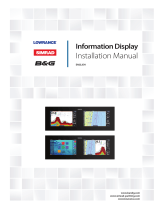
| 3
Precision-9 Installation Guide
Autocalibration
In this mode, the compass will continuously collect magnetic data and try to determine
the optimal calibration parameters. You can see the current calibration status in the setup
menu, as well as possible warnings.
There are 4 dierent modes, with slightly dierent behavior. In all modes, data is
continuously collected and new calibration parameters calculated; the dierence is in how
and when new parameters are used.
The default mode is Auto, and for most users it is not necessary to change this. However, if
you wish to make sure that the compass does not change its calibration, you can set it to
Locked once you are satised with the performance.
Select the Congure option to display the Device conguration dialog.
You select compass auto calibration mode from the drop-down list.
Auto
New calibration parameters will be phased in only if the existing parameters are invalid.
Locked
In this mode, the compass will not change the parameters in use by itself. If new
parameters are deemed better than the current ones, a warning text will be updated:
Parameters in use are not valid.
On
New calibration parameters will be phased in whenever they are deemed better than the
existing ones.
O
In this mode, no autocalibration parameters are used, and the compass uses the manual
calibration.
Statuses and warnings
Status and warnings are shown in the setup dialog.
Statuses Description
Is not calibrated The needed magnetic raw data is not yet collected.
Is calibrating
New calibration parameters have been found, and is being phased
in.
Is calibrated Calibration parameters have been found and are being used.
- - - Autocalibration is O.
Warnings Description
First calibration
in progress
Data for rst calibration is being collected.
No warning Performance of current parameters is deemed good.
Parameters in
use are not valid
Current parameters are not valid. If this is seen when the mode is
Locked, the mode should at least temporarily be set to On or Auto,
to switch parameters.
- - - Autocalibration is O.









